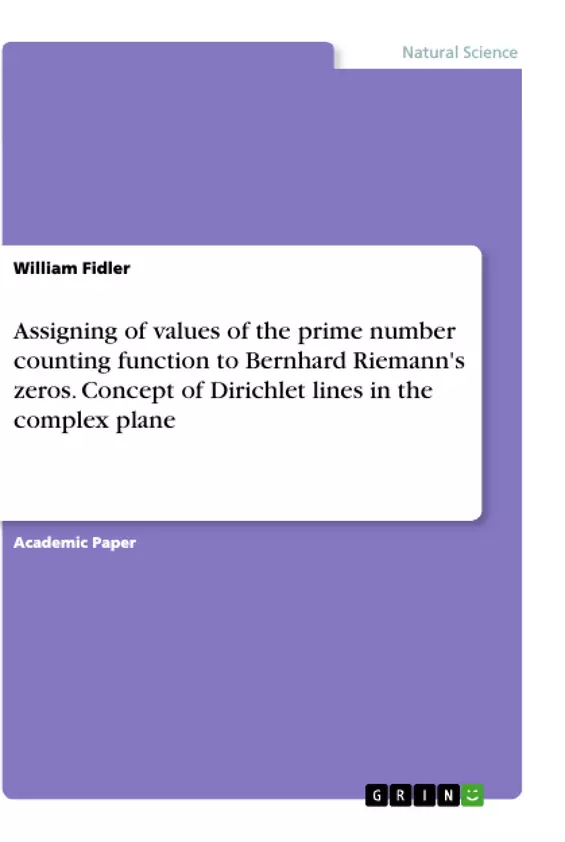Given their importance as the building blocks of all of the integers, the prime numbers, their number and dispositionwithin the integers have been studied for millennia. In 1859 Bernhard Riemann published a short paper (which only extended to six manuscript pages) concerned with an investigation of the number of prime numbers less than any given number. The outcome of the work revolutionised number theory and in the years following has resulted in almost what could be termed an industry in a particular aspect of his work, now called the Riemann Hypothesis. Riemann showed that all the zero values of the zeta function in the positive part of the complex plane should lie in a region between x = 0 and x = 1, and, in particular, conjectured that they all should lie on the line of symmetry x = ½.
This conjecture, which is the basis of many other conjectures in Number Theory is considered by many mathematicians to be the currently greatest unsolved problem in Mathematics—so much so that the Clay Mathematical Institute of Boston, Mass. has offered one million dollars to anyone who can produce a solution. No attempt is made here to verify the hypothesis, for its validity is not required. A procedure is developed here, by means of which, the zeros of Riemann's zeta function in the so-called Critical Strip of the complex plane may be assigned values of the prime number counting function. The procedure is novel and uses the concept of a Dirichlet line in the complex plane and a quantity called a nearodd (both of which are defined in the text).
The process may be rendered self-contained, in the sense that, when it is associated with Gram's series the only input required is the magnitude of the imaginary part of the function s = x + iy which will locate a Riemann zero on the Critical Line; vast numbers of zeros may be accessed in [2]. Further, it is shown that the Riemann conjecture is irrelevant in the assigning of any particular value of the prime number counting function to the corresponding Riemann zero. It is suggested, pace Wiles, who obtained a proof of Fermat's Last Theorem as a by-product of his verification of the Taniyama-Shimura conjecture, that, in the light of Godel's incompleteness theorems, Riemann's hypothesis may be undecidable.
Inhaltsverzeichnis (Table of Contents)
- Introduction
- Analysis
- Dirichlet lines in the complex plane
- Riemann zeros along the line passing through s = ½
- The assigning of values of the prime number counting function to the
- The Riemann hypothesis
- The Critical Strip
- Discussion
- References
Zielsetzung und Themenschwerpunkte (Objectives and Key Themes)
This paper aims to develop a novel procedure for assigning values of the prime number counting function to the zeros of Riemann's zeta function within the Critical Strip of the complex plane.
- Dirichlet lines in the complex plane
- Assigning values of the prime number counting function to Riemann zeros
- The Riemann Hypothesis and its relevance to the procedure
- The Critical Strip and its importance in number theory
- The use of Gram's series and the Dirichlet eta function
Zusammenfassung der Kapitel (Chapter Summaries)
The introduction provides a background on the importance of prime numbers and Riemann's work in number theory. It highlights the significance of the Riemann Hypothesis and its connection to the prime number counting function.
The analysis section delves into the mathematical foundation of the proposed procedure. It introduces the concept of Dirichlet lines in the complex plane and their role in assigning values to Riemann zeros. The paper also discusses the Dirichlet eta function and its relationship to the Riemann zeta function.
The chapter focuses on Riemann zeros lying along the line passing through s = ½. It explores the process of assigning values of the prime number counting function to these zeros.
This chapter examines the Riemann Hypothesis and its relationship to the developed procedure. It argues that the hypothesis is irrelevant in assigning specific values of the prime number counting function to Riemann zeros.
The section discusses the concept of the Critical Strip in the complex plane and its importance in understanding the distribution of Riemann zeros. It emphasizes the relevance of the Critical Strip to the proposed procedure.
Schlüsselwörter (Keywords)
The main keywords and focus topics of the text include Riemann zeta function, Riemann Hypothesis, prime number counting function, Dirichlet lines, Dirichlet eta function, Critical Strip, Gram's series, complex plane, number theory.
- Quote paper
- William Fidler (Author), 2022, Assigning of values of the prime number counting function to Bernhard Riemann's zeros. Concept of Dirichlet lines in the complex plane, Munich, GRIN Verlag, https://www.hausarbeiten.de/document/1168625


